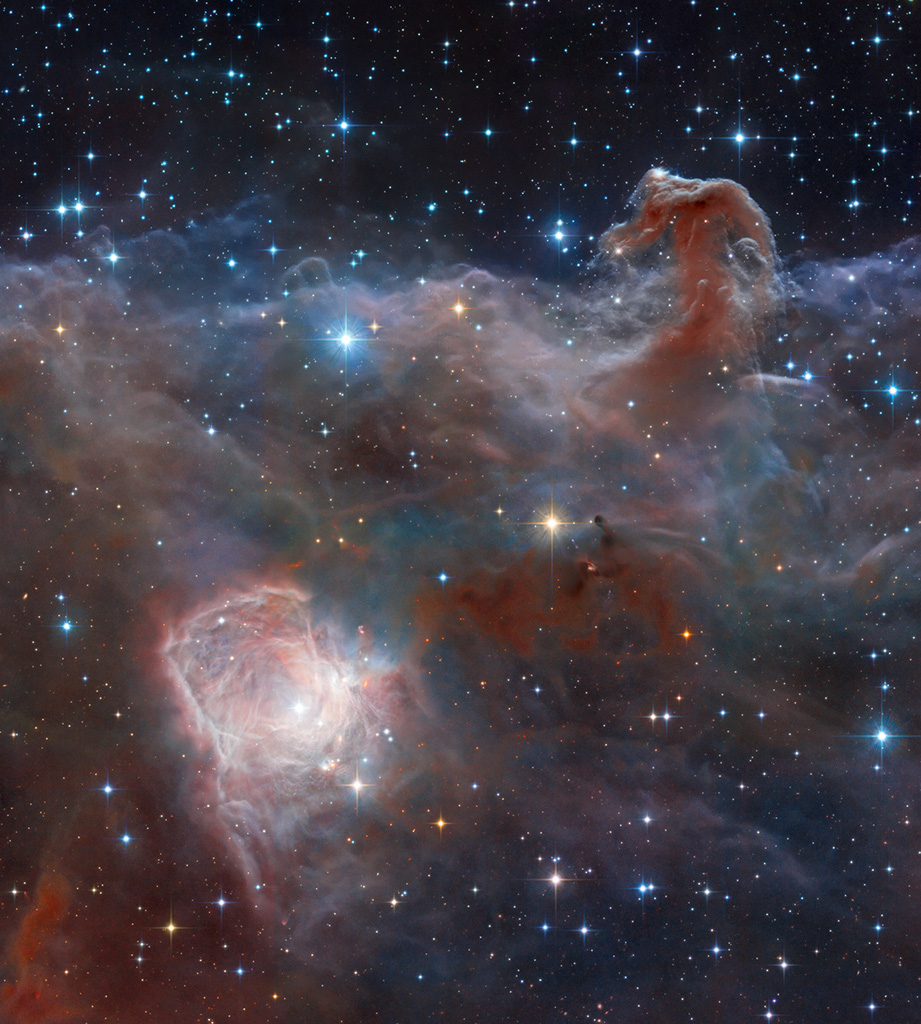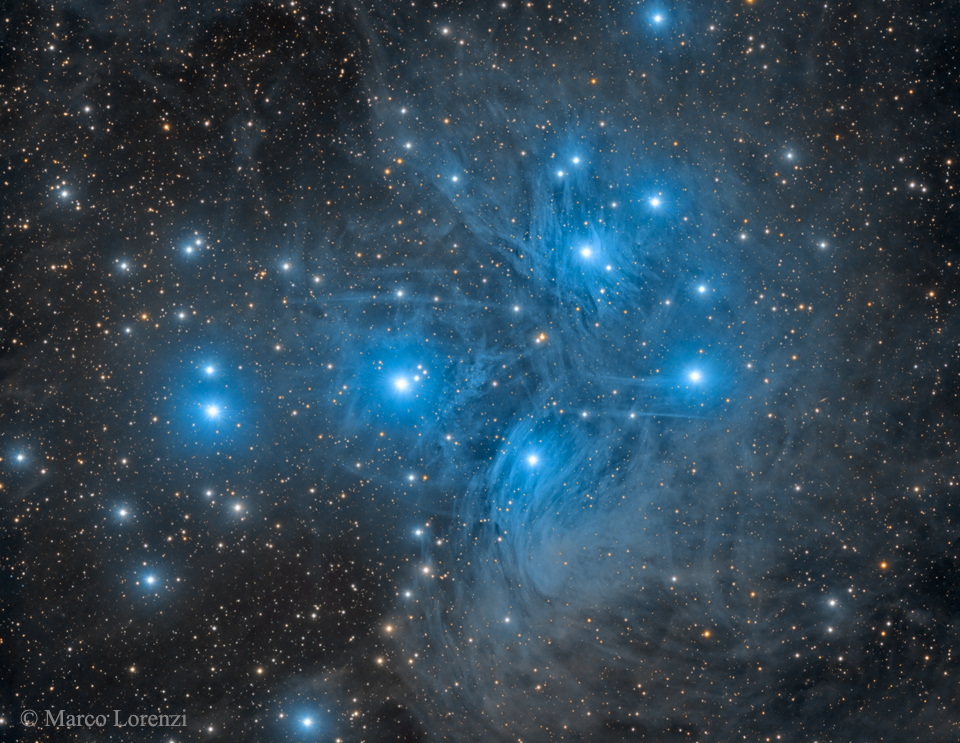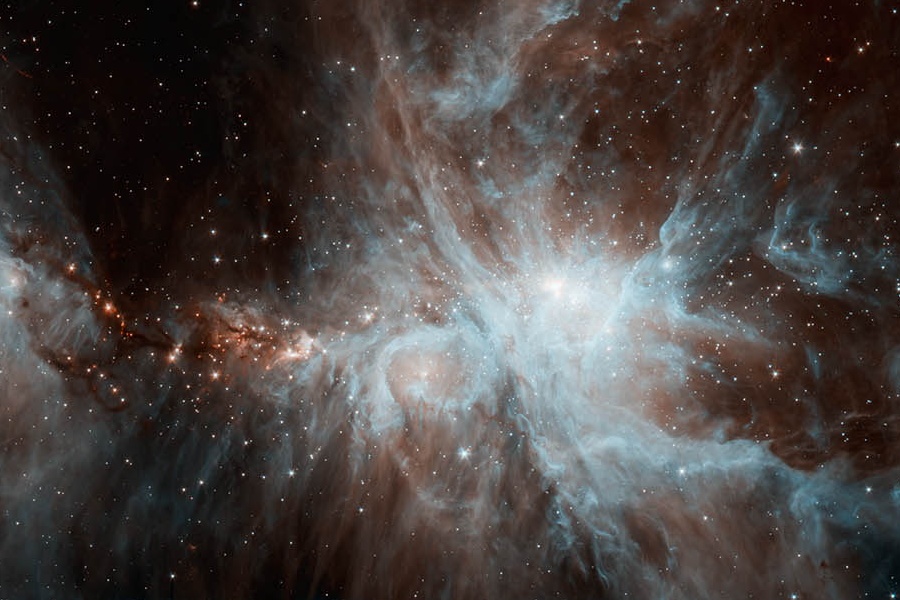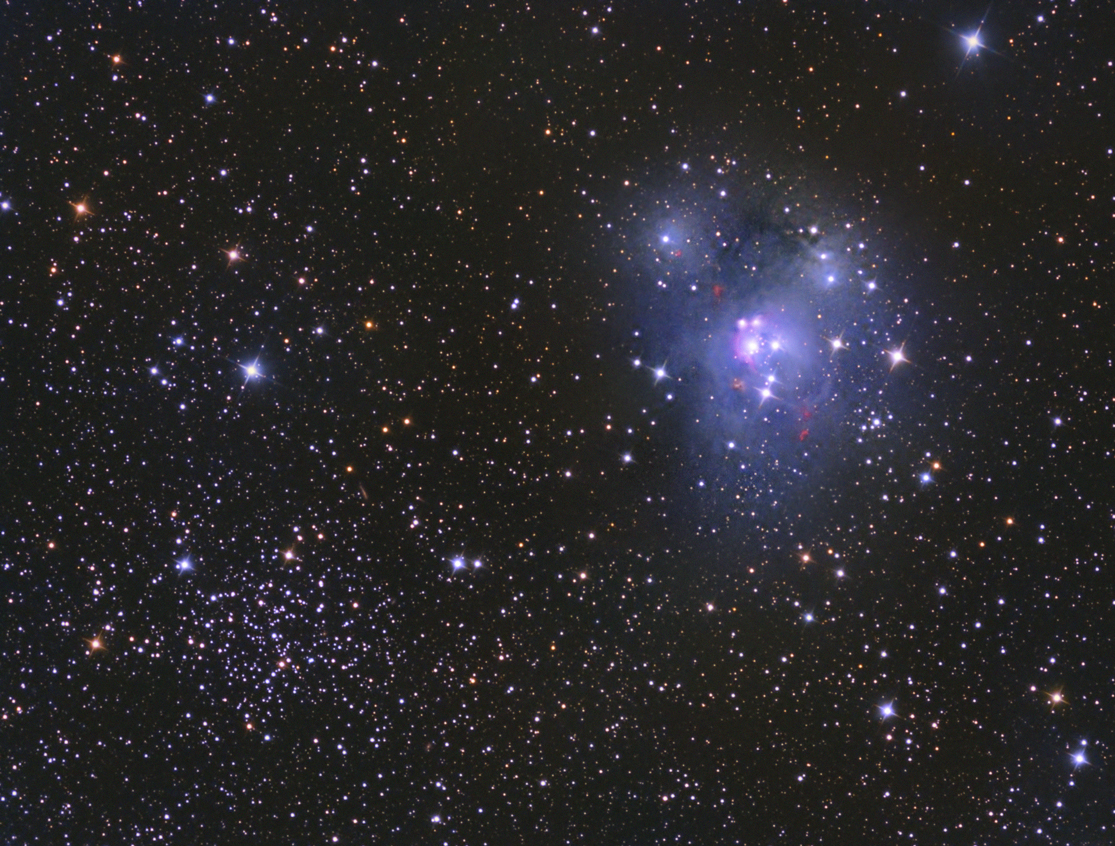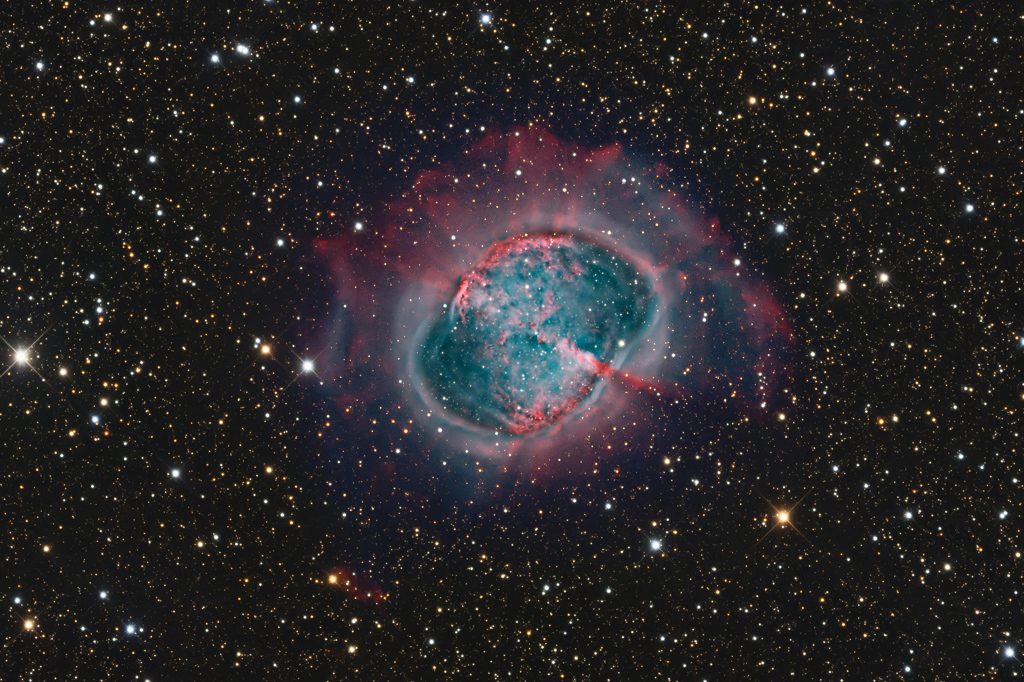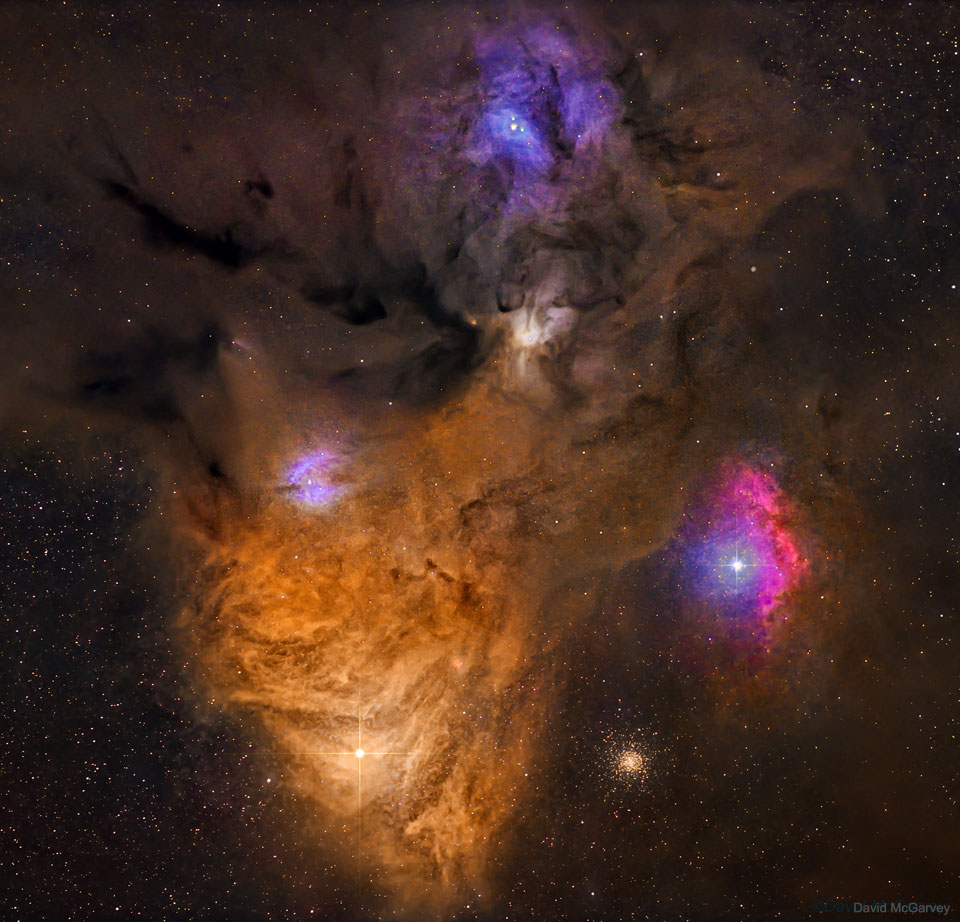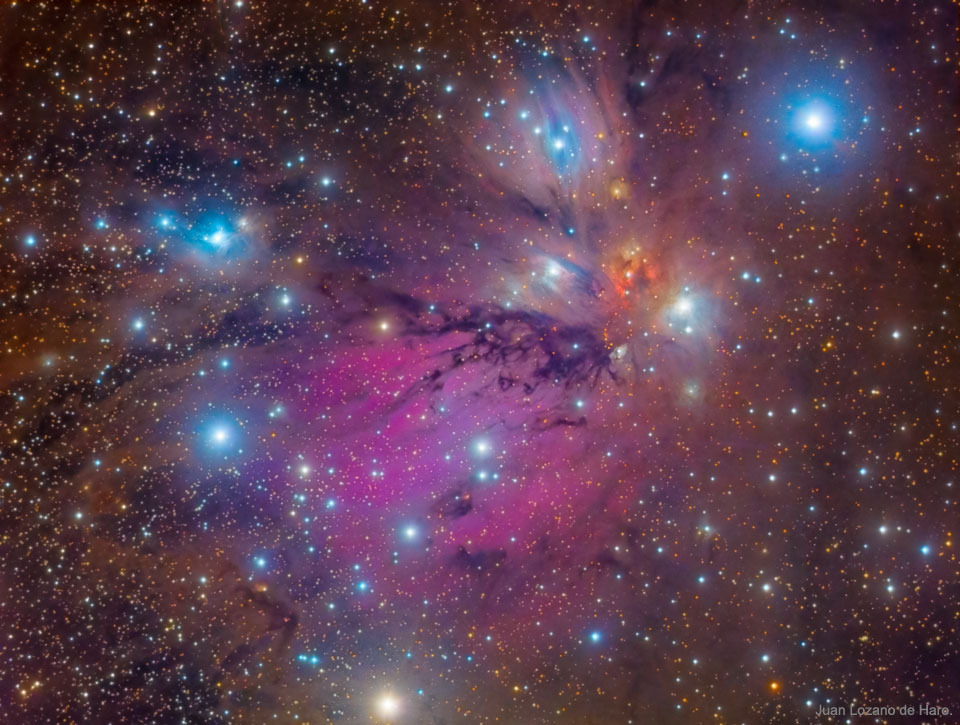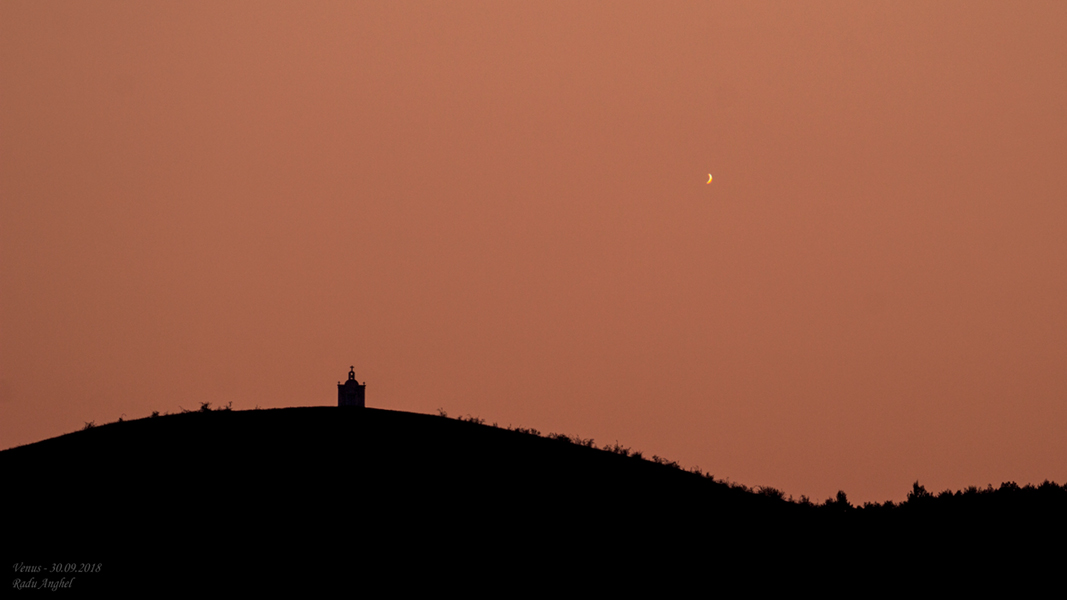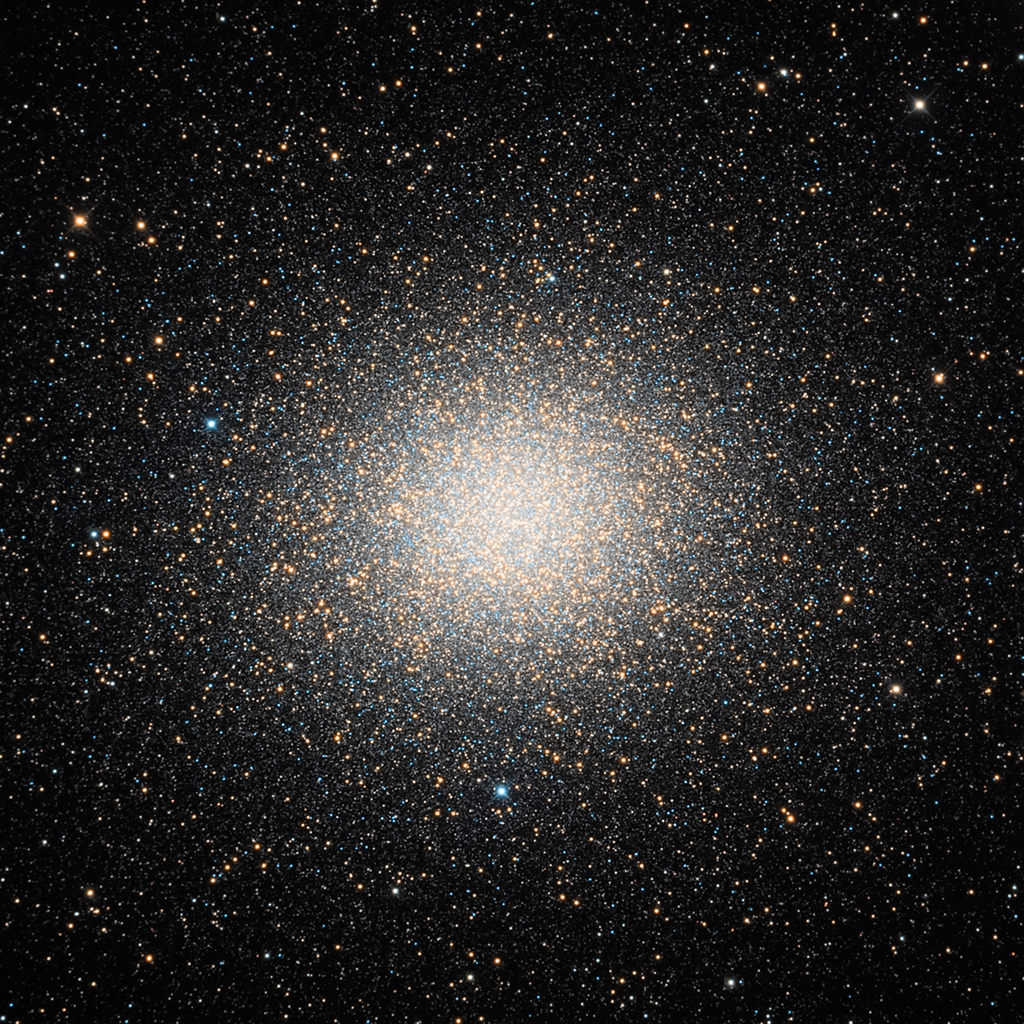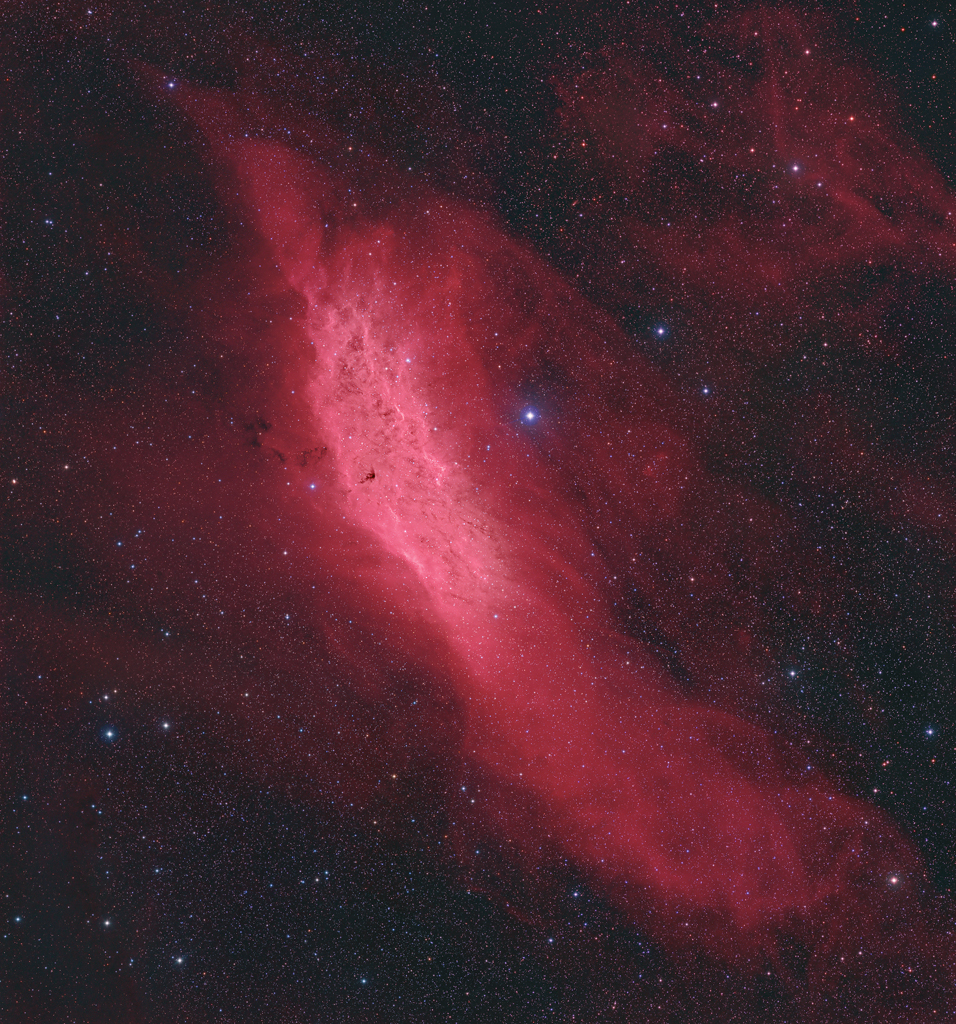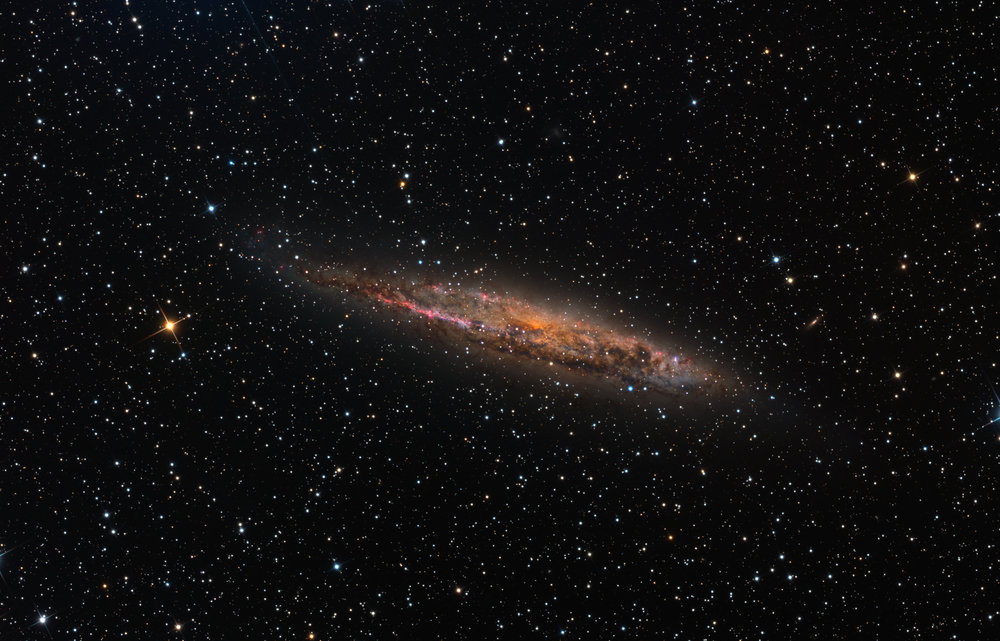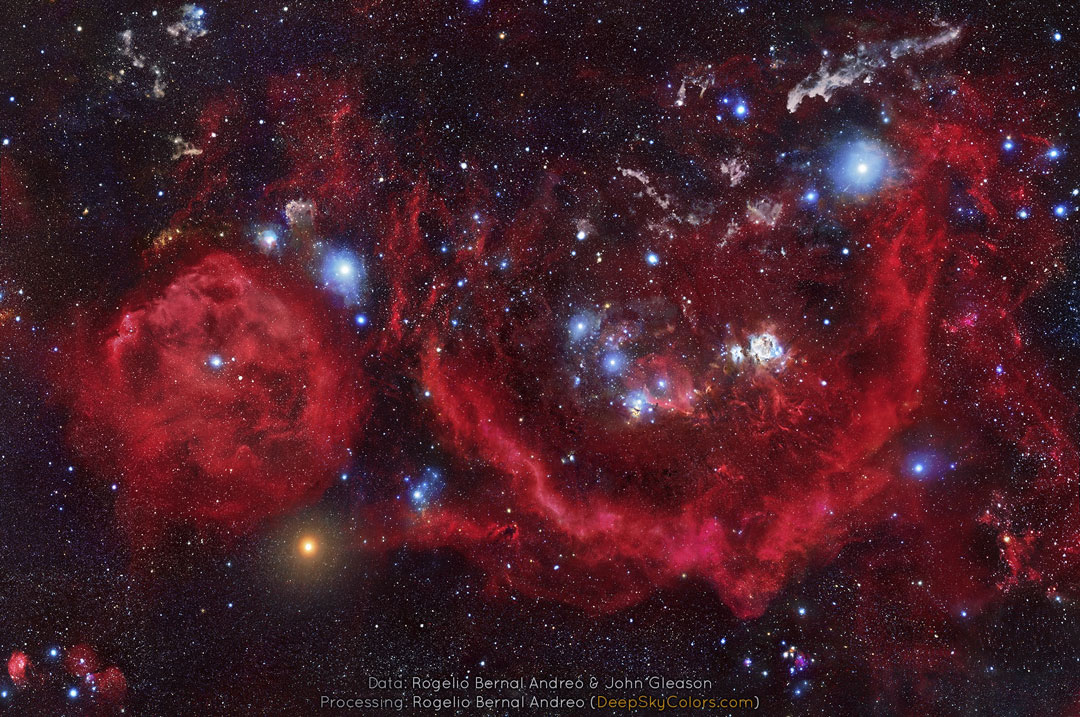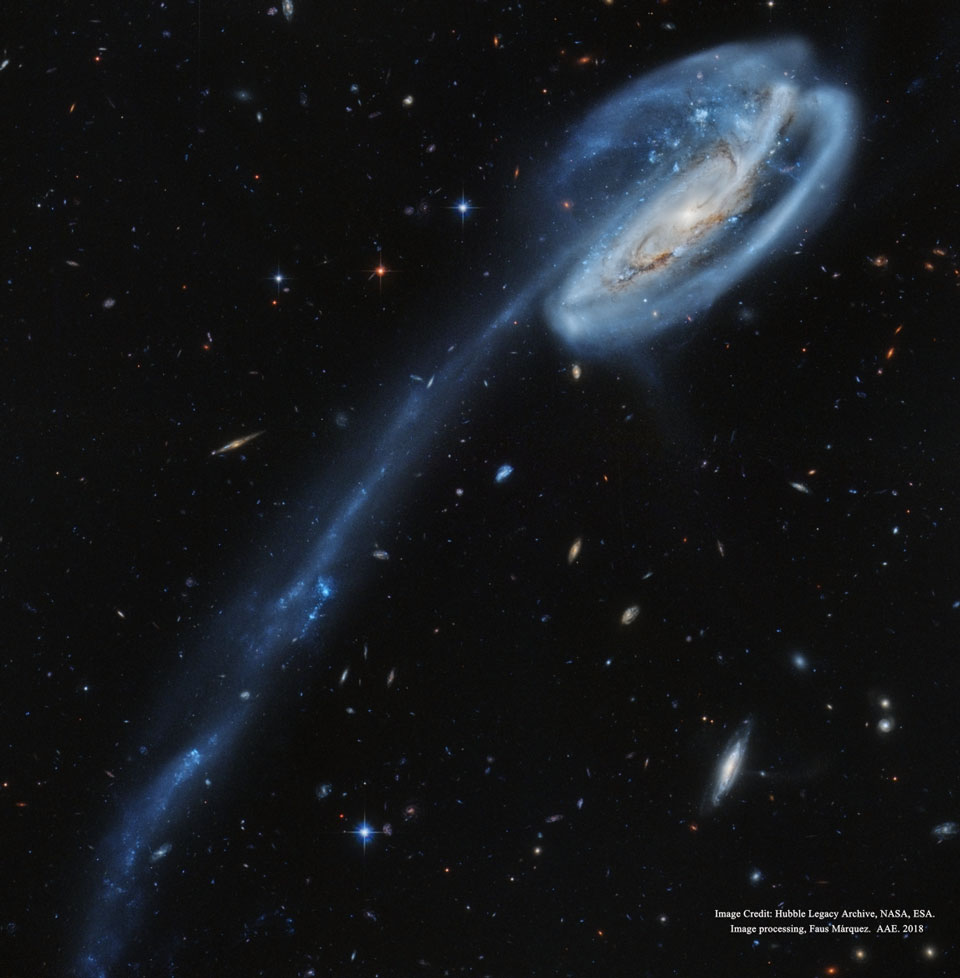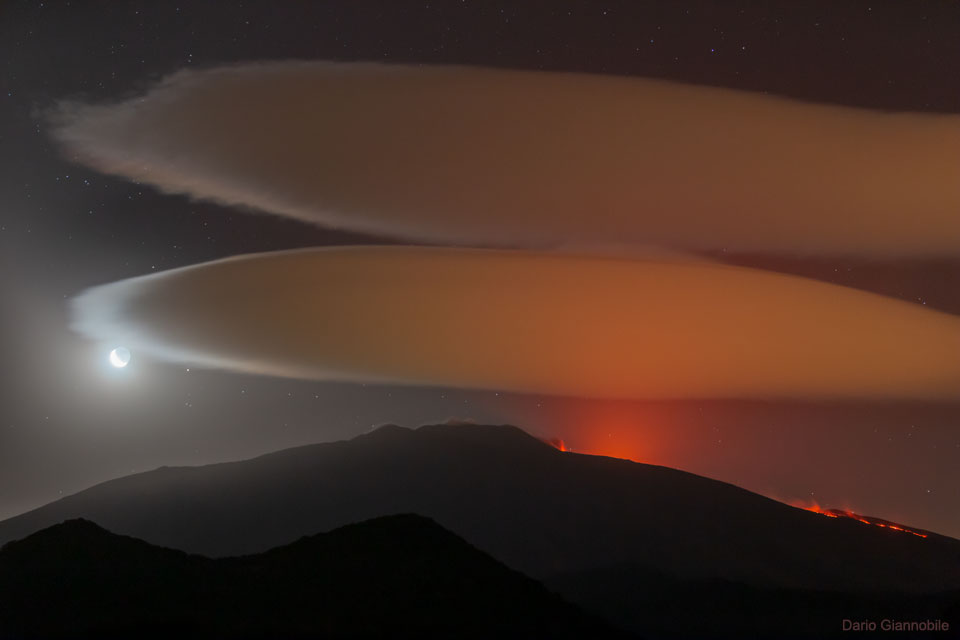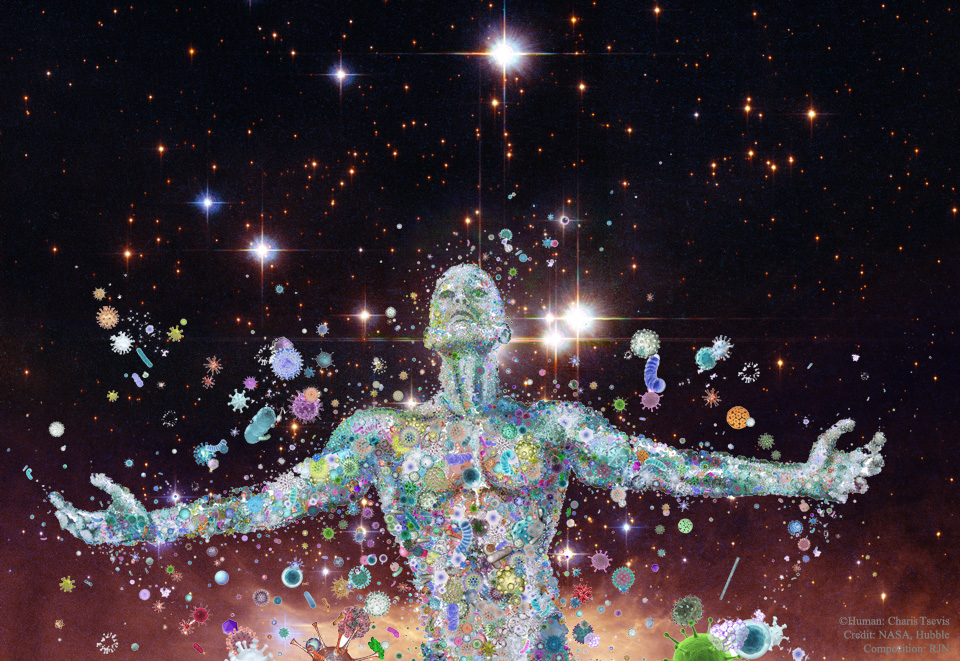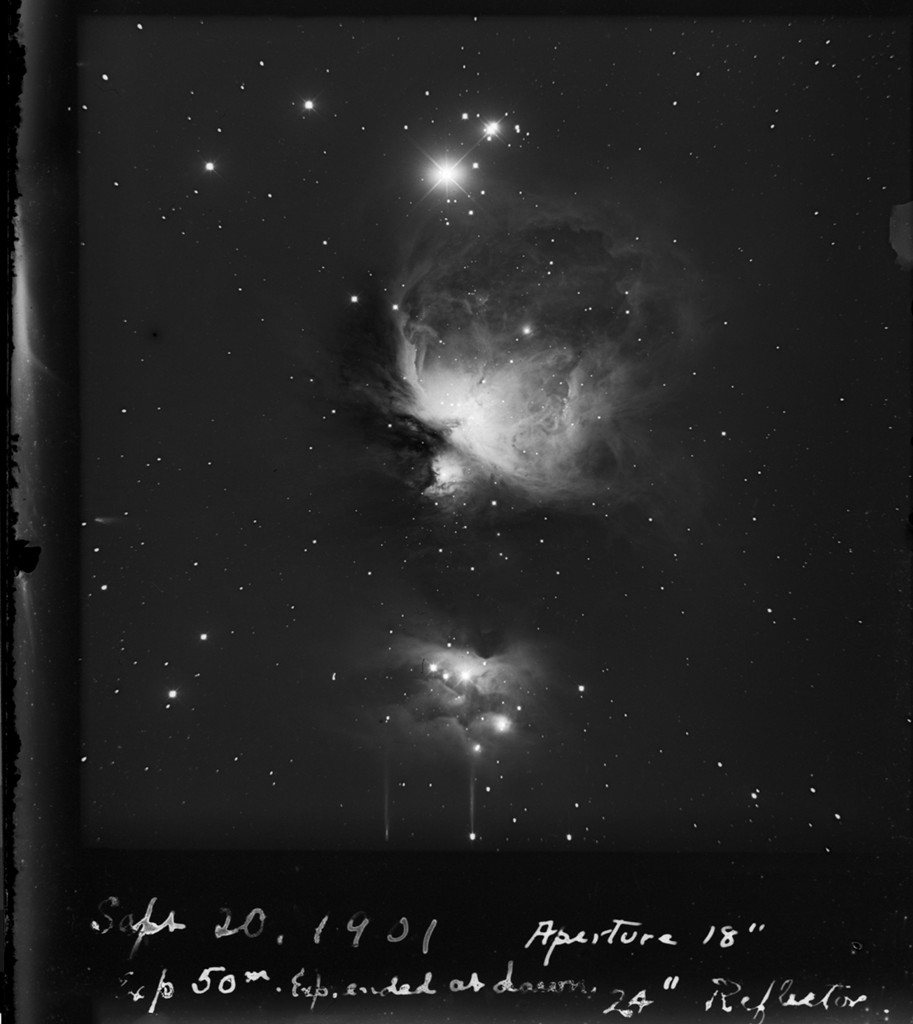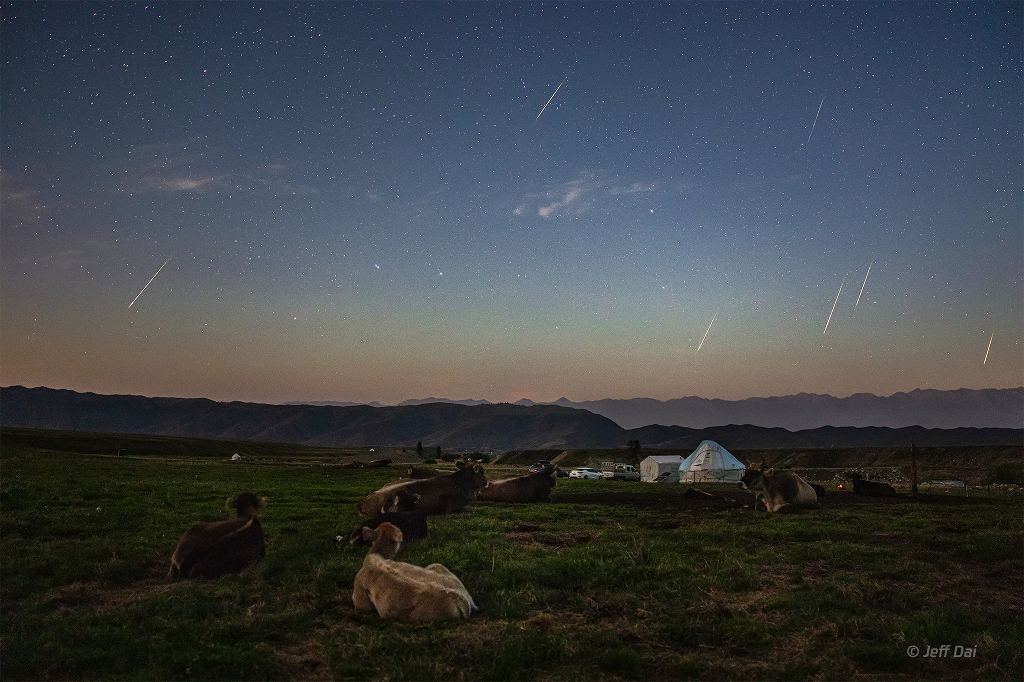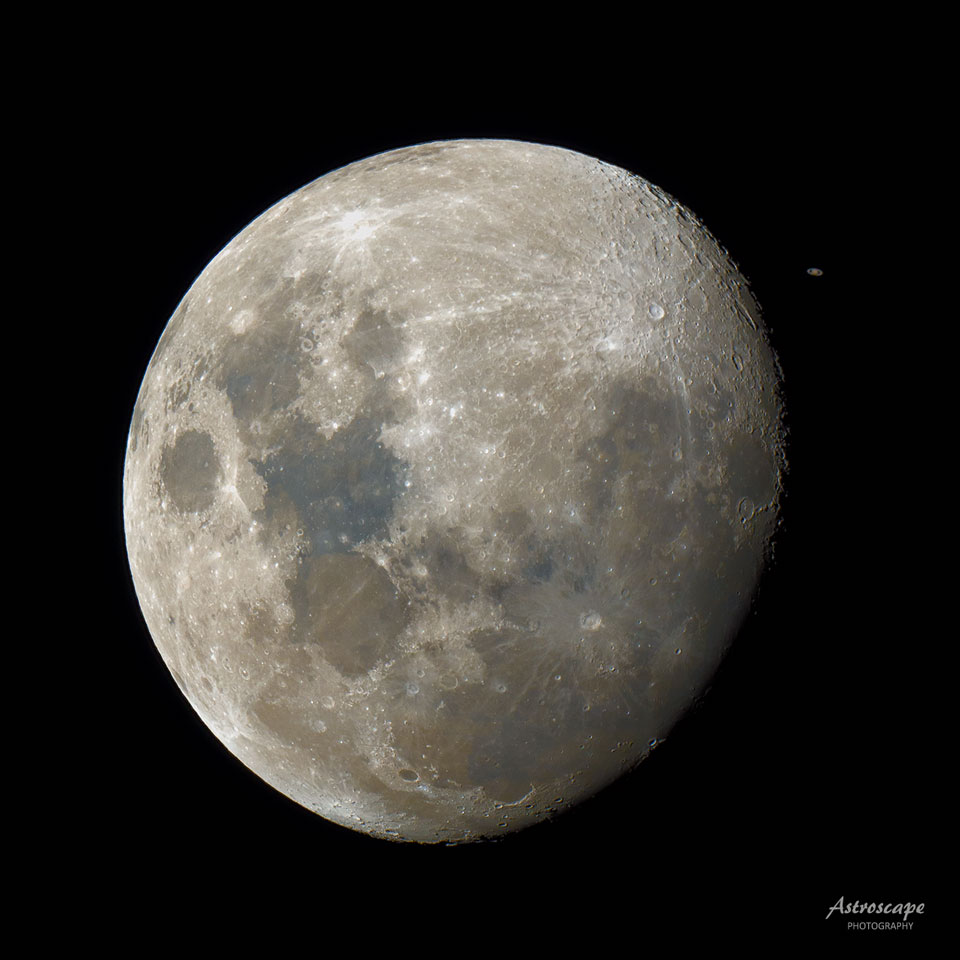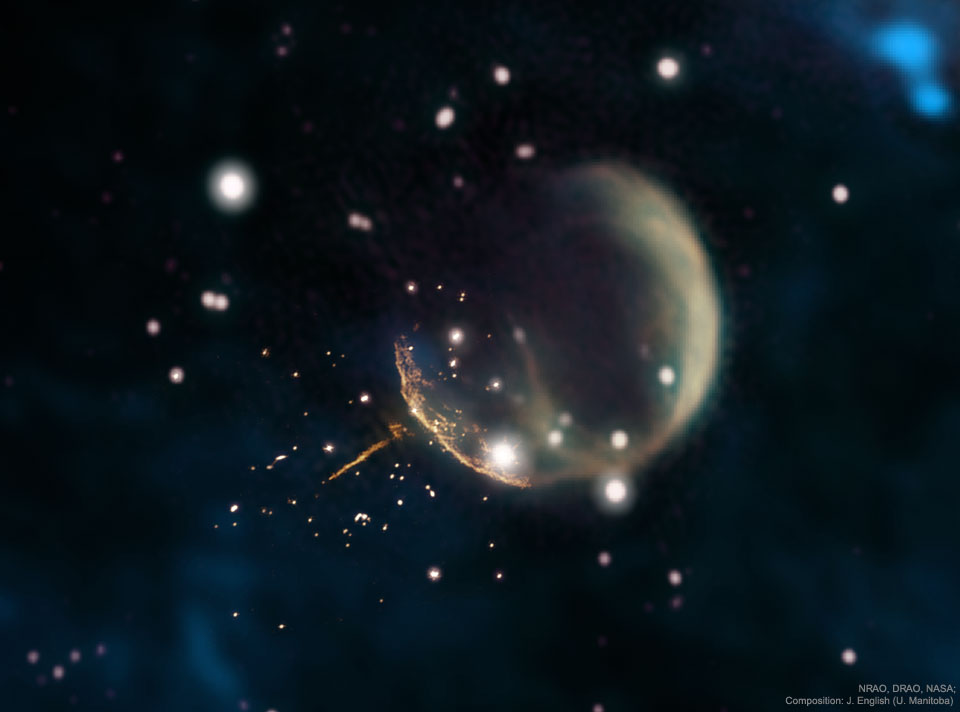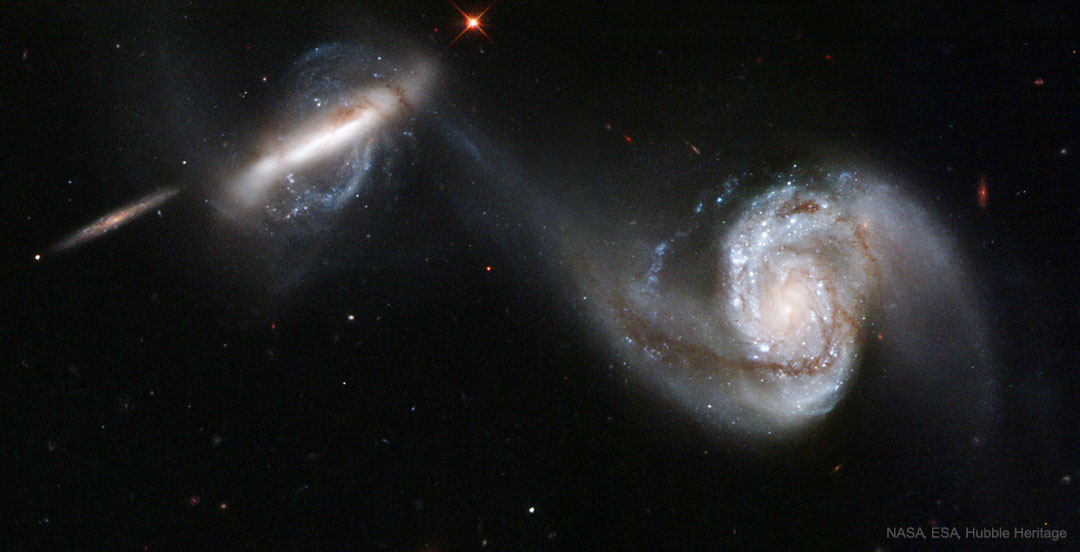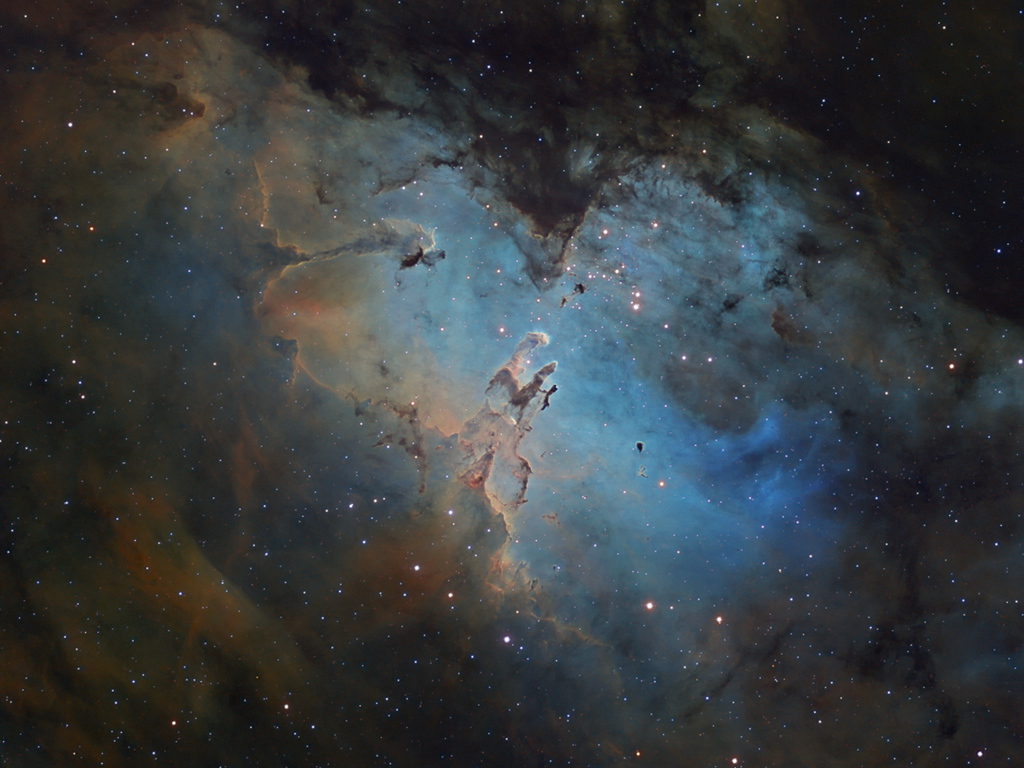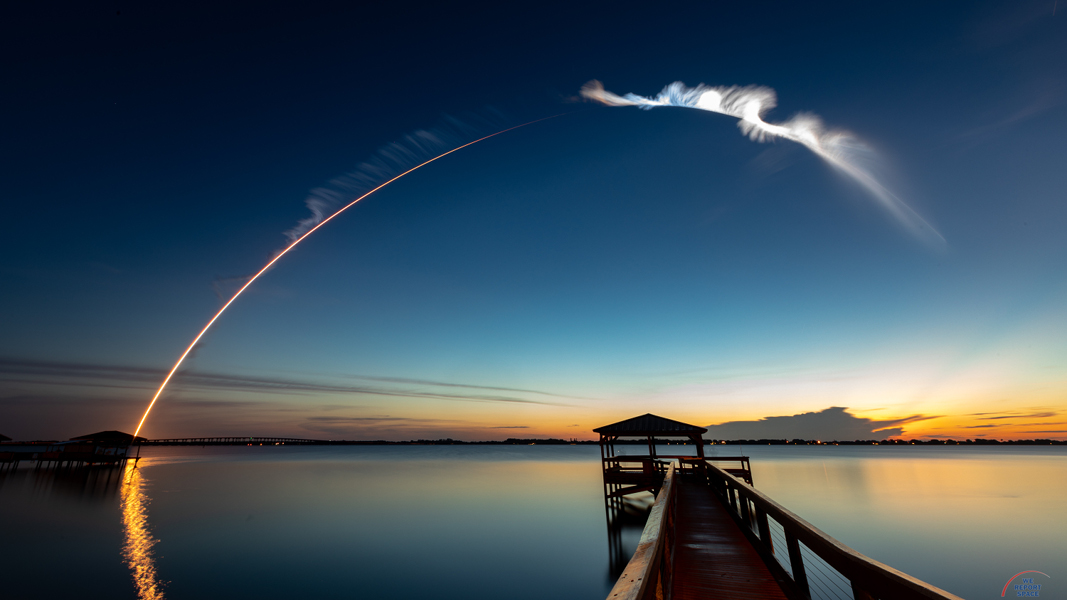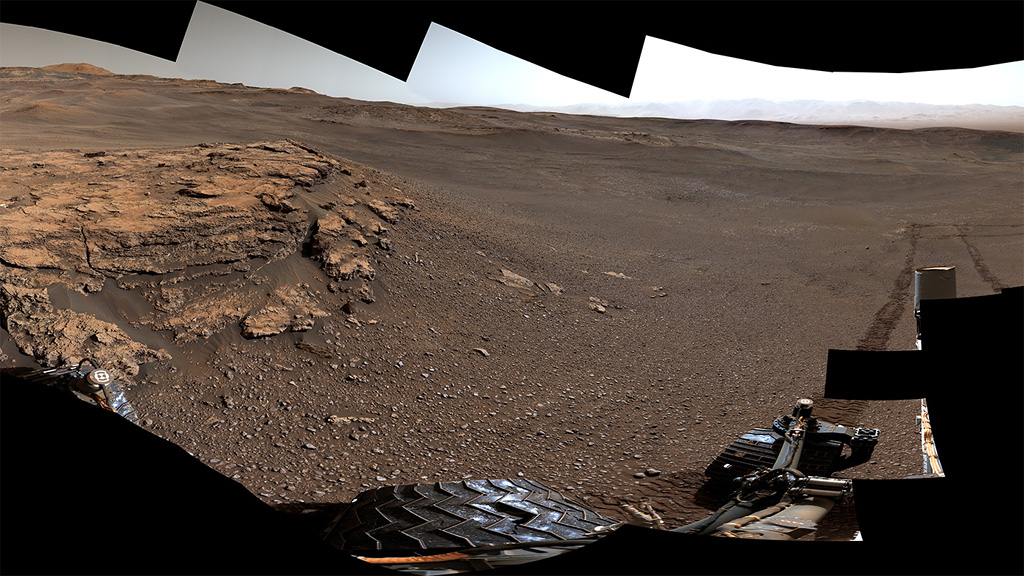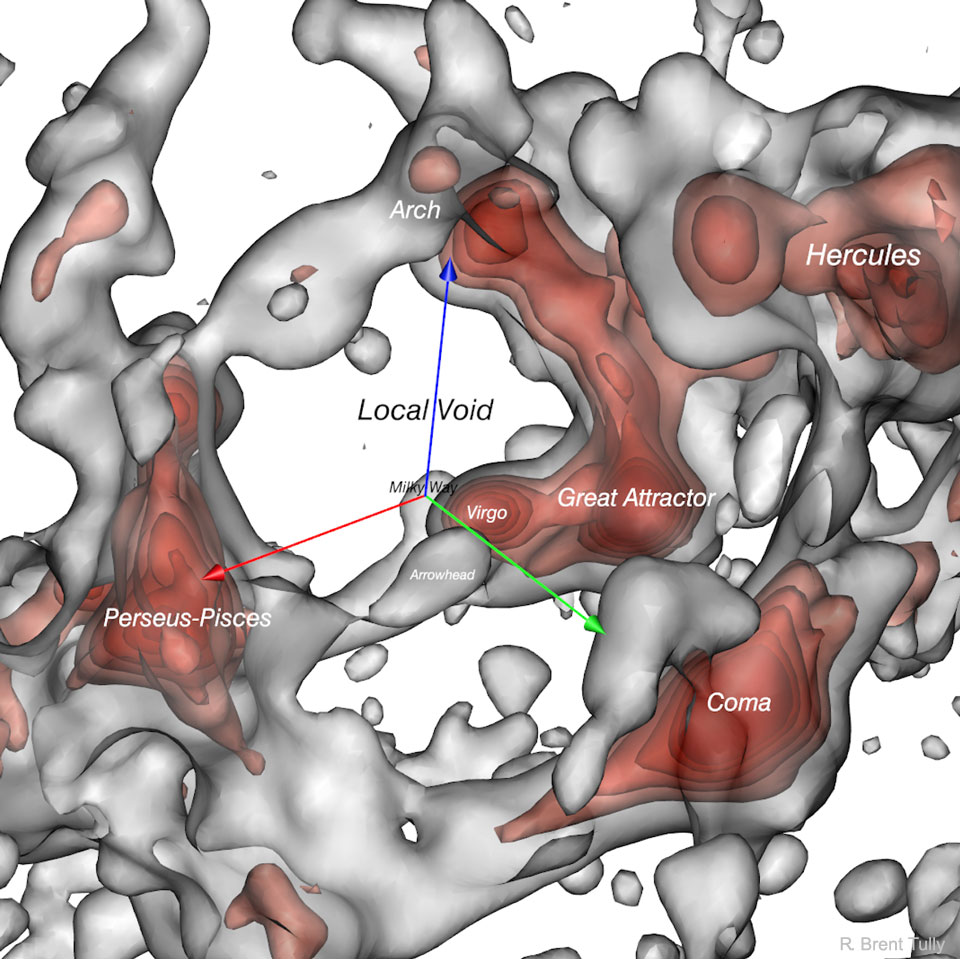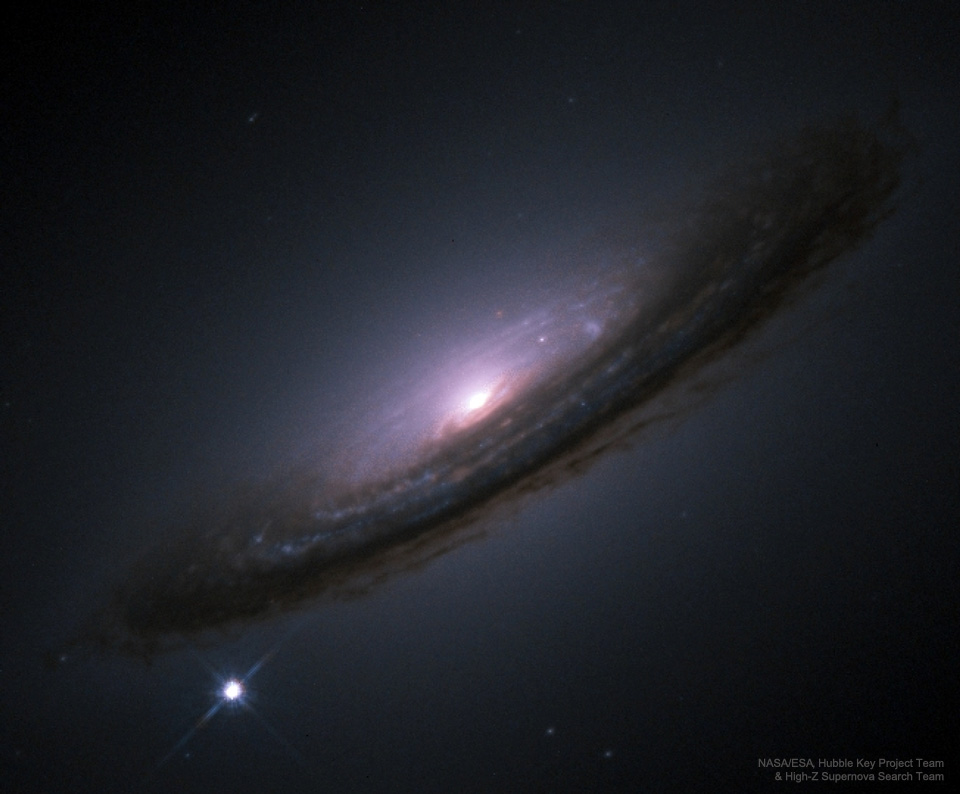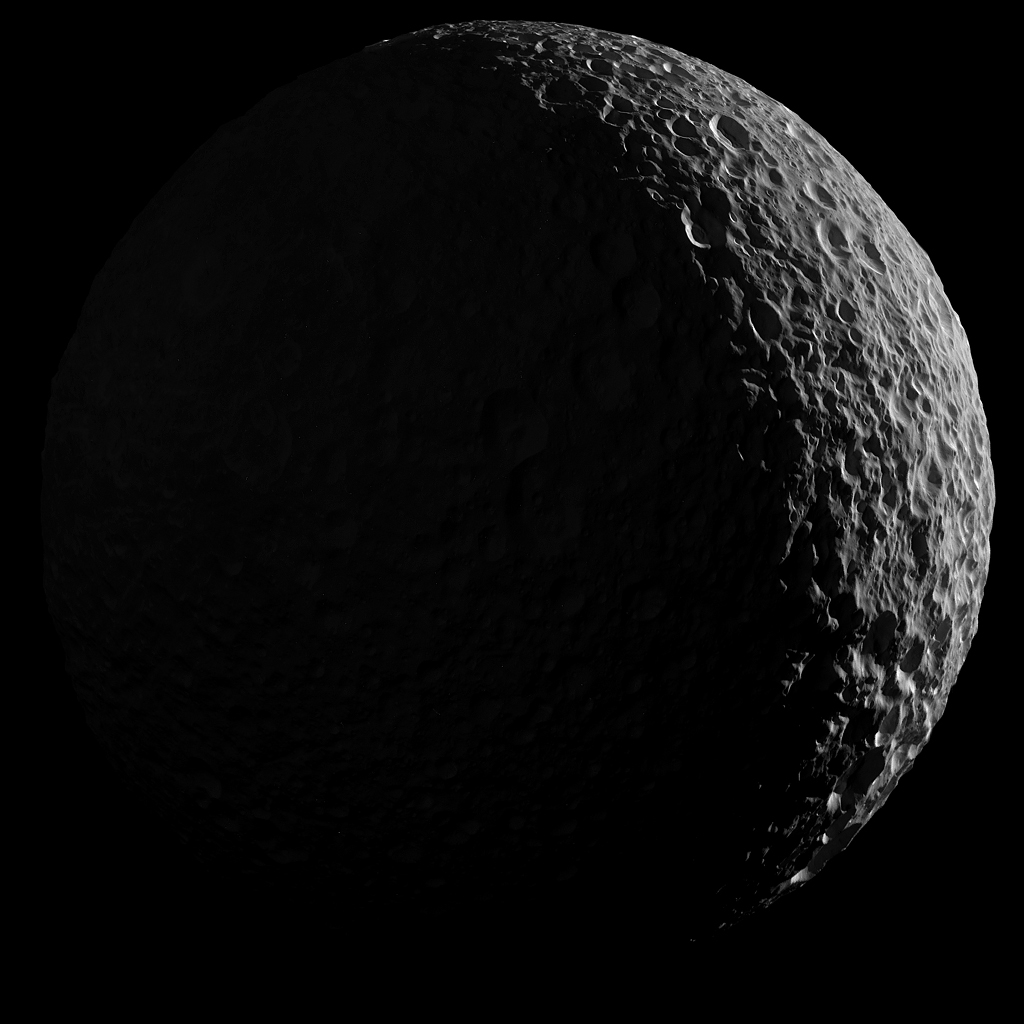
|
| Title: NASA pics | |
| Grapevine50sRoost > ~GENERAL~ > GENERAL DISCUSSION | Go to subcategory: |
| Author | Content |
|
zxxlyzq
|
|
|
Date Posted:09/03/2018 12:10 PMCopy HTML Composition and Processing: Robert Gendler Image Data: ESO, VISTA, HLA, Hubble Heritage Team (STScI/AURA) Explanation: Combined image data from the massive, ground-based VISTA telescope and the Hubble Space Telescope was used to create this wide perspective of the interstellar landscape surrounding the famous Horsehead Nebula. Captured at near-infrared wavelengths, the region's dusty molecular cloud sprawls across the scene that covers an angle about two-thirds the size of the Full Moon on the sky. Left to right the frame spans just over 10 light-years at the Horsehead's estimated distance of 1,600 light-years. Also known as Barnard 33, the still recognizable Horsehead Nebula stands at the upper right, the near-infrared glow of a dusty pillar topped with newborn stars. Below and left, the bright reflection nebula NGC 2023 is itself the illuminated environs of a hot young star. Obscuring clouds below the base of the Horsehead and on the outskirts of NGC 2023 show the tell-tale far red emission of energetic jets, known as Herbig-Haro objects, also associated with newborn stars. |
|
|
Rockymz
|
Share to:





 #1651
#1651
|
|
Re:NASA pics Date Posted:02/09/2019 6:45 AMCopy HTML Image Credit & Copyright: Giorgia Hofer(Cortina Astronomical Association)
Explanation: What are those bright lights in the sky ahead? When hiking a high mountain pass in northern Italy three weeks ago, a conjunction between our Moon and the distant planet Jupiter was visible as both rose together in the southwest after sunset. The picturesque mountains in the distance are Tre Cime di Lavaredo (Three Peaks of Lavaredo), a UNESCO World Heritage Site and three of the best known mountain peaks in Italy, the Dolomites, and the entire Alps. In the foreground on the left is Locatelli Hut, a refuge for tired hikers as it is located over an hour from nearest parking lot. The bright sky object on the upper left is Saturn. The entire scene was captured on a single 8-second exposure. Jupiter and Saturn will remain prominent in the western sky after sunset this month, while the Moon, in its monthly orbit around the Earth, will pass near Jupiter again in about four days. |
|
|
Rockymz
|
Share to:





 #1652
#1652
|
|
Re:NASA pics Date Posted:01/09/2019 6:14 AMCopy HTML Image Credit & Copyright: Marco Lorenzi (Glittering Lights)
Explanation: Have you ever seen the Pleiades star cluster? Even if you have, you probably have never seen it as dusty as this. Perhaps the most famous star cluster on the sky, the bright stars of the Pleiadescan be seen without binoculars from even the depths of alight-polluted city. With a long exposure from a dark location, though, the dust cloud surrounding the Pleiades star cluster becomes very evident. The featured exposure took over 12 hours and covers a sky area several times the size of the full moon. Also known as the Seven Sisters andM45,the Pleiades lies about 400 light years away toward the constellation of the Bull (Taurus). A common legend with a modern twist is that one of the brighter stars faded since the cluster was named, leaving only six stars visible to the unaided eye. The actual number of Pleiades stars visible, however, may be more or less than seven, depending on the darkness of the surrounding sky and the clarity of the observer's eyesight. |
|
|
Rockymz
|
Share to:





 #1653
#1653
|
|
Re:NASA pics Date Posted:31/08/2019 5:56 AMCopy HTML Image Credit: NASA,JPL-Caltech
Explanation: Few cosmic vistas excite the imagination likethe Orion Nebula, an immense stellar nursery some 1,500 light-years away. Spanning about 40 light-years across the region,this infrared imagefrom the Spitzer Space Telescope was constructed from data intended tomonitor the brightness of the nebula's young stars, many still surrounded by dusty, planet-forming disks. Orion's young stars are only about 1 million years old, compared to the Sun's age of 4.6 billion years. The region's hottest stars are found in theTrapezium Cluster, the brightest cluster near picture center.Launched into orbit around the Sunon August 25, 2003 Spitzer's liquid heliumcoolant ran out in May 2009. The infrared space telescope continues to operate though, its mission scheduled to end on January 30, 2020. Recorded in 2010, this false color view is from two channels that still remain sensitive toinfrared lightat Spitzer's warmer operating temperatures. |
|
|
Rockymz
|
Share to:





 #1654
#1654
|
|
Re:NASA pics Date Posted:30/08/2019 6:25 AMCopy HTML Image Credit &Copyright: Steve Cannistra(StarryWonders)
Explanation: This wide-fieldtelescopic image looks toward the constellationCepheusand an intriguing visual pairing of dustyreflection nebulaNGC 7129 (right) andopen star cluster NGC 7142. The two appear separated by only half a degree on the sky, but they actually lie at quite different distances. In the foreground,dusty nebula NGC 7129is about 3,000 light-years distant, while open clusterNGC 7142 is likely over 6,000 light-years away. In fact, pervasive and clumpy foreground dust clouds in this region redden the light from NGC 7142,complicating astronomical explorations of the cluster. Still, NGC 7142 is thought to be anolder open star cluster, while the bright stars embedded in NGC 7129 are perhaps a few million years young. The telltale reddish crescent shapes around NGC 7129 are associated withenergetic jets streaming away from newborn stars. |
|
|
Rockymz
|
Share to:





 #1655
#1655
|
|
Re:NASA pics Date Posted:29/08/2019 6:03 AMCopy HTML Image Credit &Copyright: Bob Franke
Explanation: While hunting for comets in the skies above 18th century France,astronomer Charles Messierdiligently kept a list of the things he encountered that were definitely not comets. This is number 27 on hisnow famous not-a-comet list. In fact, 21st century astronomers would identify it as aplanetary nebula, but it's not a planet either, even though it mayappear round and planet-like in a small telescope. Messier 27 (M27) is an excellent example of a gaseous emission nebula created as a sun-like star runs outof nuclear fuel in its core. The nebula forms as the star's outer layers are expelled into space, with a visible glow generated by atoms excited by the dying star's intense but invisibleultraviolet light. Known by the popular name of theDumbbell Nebula, the beautifully symmetric interstellar gas cloud is over 2.5 light-years across and about 1,200 light-years away in theconstellation Vulpecula. This impressive color composite highlights details within the well-studied central region and fainter, seldom imaged features in the nebula's outer halo. It incorporates broad and narrowbandimages recorded usingfilters sensitive to emission from hydrogen and oxygen atoms. |
|
|
Rockymz
|
Share to:





 #1656
#1656
|
|
Re:NASA pics Date Posted:28/08/2019 6:22 AMCopy HTML Image Credit: NASA, ESA, Hubble, ESO, Amateur Data; Processing & Copyright: Robert Gendler & Roberto Colombari
Explanation: Image data from the Hubble Space Telescope, the European Southern Observatory, and small telescopes on planet Earth are combined in this magnificent portrait of face-on spiral galaxy Messier 61 (M61). A mere 55 million light-years away in the Virgo Cluster of Galaxies,M61 is alsoknown as NGC 4303. It's considered to be an example of a barred spiral galaxy similar toour own Milky Way. Like other spiral galaxies, M61 also features sweeping spiral arms, cosmic dust lanes, pinkish star forming regions, and young blue star clusters. The bright galactic core is offset to the left in this50 thousand light-year wide close-up. |
|
|
Rockymz
|
Share to:





 #1657
#1657
|
|
Re:NASA pics Date Posted:27/08/2019 6:39 AMCopy HTML Image Credit: David McGarvey
Explanation: Why is the sky near Antares and Rho Ophiuchi so dusty yet colorful? The colors result from a mixture of objects and processes. Fine dust illuminated from the front by starlight produces bluereflection nebulae. Gaseous clouds whose atoms are excited by ultraviolet starlight produce reddish emission nebulae. Backlit dust clouds block starlight and soappear dark. Antares, a red supergiant and one of the brighter stars in the night sky, lights up the yellow-red clouds on the lower left of the featured image.Rho Ophiuchilies at the center of the blue nebula near the top. The distant globular cluster M4 is visible to the right of Antares. These star clouds are even more colorful than humans can see, emitting light across the electromagnetic spectrum. |
|
|
Rockymz
|
Share to:





 #1658
#1658
|
|
Re:NASA pics Date Posted:26/08/2019 5:36 AMCopy HTML Image Credit & Copyright: Juan Lozano de Haro
Explanation: Is this a painting or a photograph? In this classic celestialstill life composed with a cosmic brush, dusty nebulaNGC 2170, also known as the Angel Nebula, shines near the image center. Reflecting the light of nearby hot stars, NGC 2170 is joined by other bluish reflection nebulae, a red emission region, many dark absorption nebulae, and a backdrop of colorful stars. Like the common household items that still life painters often choose for their subjects, the clouds of gas, dust, and hot starsfeatured here are also commonly found in this setting -- a massive, star-forming molecular cloud in the constellation of the Unicorn (Monoceros). The giantmolecular cloud, Mon R2, is impressively close, estimatedto be only 2,400 light-years or so away. At that distance, this canvas would be over 60 light-years across. |
|
|
Rockymz
|
Share to:





 #1659
#1659
|
|
Re:NASA pics Date Posted:25/08/2019 6:02 AMCopy HTML Image Credit &Copyright: Radu-Mihai Anghel
Explanation: That's not a young crescent Moonpoised above the hills along the western horizon at sunset. It's Venus in a crescent phase. About 54 million kilometers away and less than 20 percent illuminated, it was captured by telescope and camera on September 30 near Bacau, Romania. The bright celestial beacon is now languishing in the evening twilight, its days as the Evening Star in 2018 coming to a close. But it also grows larger in apparent size and becomes an ever thinner crescent intelescopic views. Heading toward aninferior conjunction (non-judgmental), the inner planet will be positioned between Earth and Sun on October 26 and lost from view in the solar glare. At month's end a crescent Venus will reappear in the east though, rising just before the Sun as the brilliantMorning Star. |
|
|
Rockymz
|
Share to:





 #1660
#1660
|
|
Re:NASA pics Date Posted:24/08/2019 5:56 AMCopy HTML Image Credit &Copyright: Michael Miller,Jimmy Walker
Explanation: Globular star clusterOmega Centauri, also known as NGC 5139, is some 15,000 light-years away. The cluster is packed with about 10 million stars much older than the Sun within a volume about 150 light-years in diameter. It's the largest and brightest of 200 or so knownglobular clusters that roam the halo of our Milky Way galaxy. Though most star clusters consist of stars with the same age and composition, the enigmatic Omega Cen exhibits the presence ofdifferentstellar populations with a spread of ages and chemical abundances. In fact,Omega Cen may be the remnant core of a small galaxy merging with the Milky Way. |
|
|
Rockymz
|
Share to:





 #1661
#1661
|
|
Re:NASA pics Date Posted:23/08/2019 6:18 AMCopy HTML Image Credit &Copyright: Sara Wager
Explanation: Drifting through the Orion Arm of the spiral Milky Way Galaxy,this cosmic cloudby chance echoes the outline of California on the west coast of the United States. Our own Sun also lies within the Milky Way'sOrion Arm, only about 1,500 light-years from the California Nebula. Also known as NGC 1499, the classic emission nebula is around 100 light-years long. The California Nebula shines with the telltale reddish glow characteristic of hydrogen atoms recombining with long lostelectrons. The electrons have been stripped away, ionized by energetic starlight. Most likely providing the energetic starlight that ionizes much of the nebular gas is the bright, hot, bluish starXi Perseijust to the right of the nebula. A popular target for astrophotographers, this deepCalifornia Nebula imageis a 6 panel telecopic mosaic and covers awide field of view.The nebula lies toward the constellationPerseus, not far from the Pleiades. |
|
|
Rockymz
|
Share to:





 #1662
#1662
|
|
Re:NASA pics Date Posted:22/08/2019 5:51 AMCopy HTML Image Credit &Copyright: Martin Pugh
Explanation: Large spiral galaxy NGC 4945 is seenedge-onnear the center of thiscosmic galaxy portrait. In fact, it's almost the size of ourMilky Way Galaxy. NGC 4945's own dusty disk, young blue star clusters, and pink star forming regions standout in the sharp, colorful telescopic image. About 13 million light-years distant toward theexpansive southern constellation Centaurus, NGC 4945 is only about six times farther away than Andromeda, the nearest large spiral galaxy to the Milky Way. Though this galaxy's central region is largely hidden from view for optical telescopes, X-ray and infrared observations indicatesignificanthigh energy emission and star formation in the coreof NGC 4945. Its obscured but active nucleus qualifies the gorgeous island universe as a Seyfert galaxyand home to a central supermassive black hole. |
|
|
Rockymz
|
Share to:





 #1663
#1663
|
|
Re:NASA pics Date Posted:21/08/2019 6:11 AMCopy HTML Image Credit & Copyright: John Gleason&Rogelio Bernal Andreo
Explanation: Do you recognize this constellation? Although it is one of the most recognizable star groupings on the sky, this is a more full Orion than you can see -- an Orion only revealed with long exposure digital camera imaging and post-processing. Here the cool red giant Betelgeuse takes on a strong orange tint as the brightest star at the lower left. Orion's hot blue stars are numerous, with supergiant Rigel balancing Betelgeuse on the upper right, and Bellatrix at the upper left. Lined up in Orion's belt are three stars all about 1,500 light-years away, born from the constellation's well-studied interstellar clouds. To the right of Orion's belt is a bright but fuzzy patch that might also look familiar -- the stellar nursery known as Orion's Nebula. Finally, just barely visible to the unaided eye but quite striking here is Barnard's Loop -- a huge gaseous emission nebula surrounding Orion's Belt and Nebula discovered over 100 years ago by the pioneering Orion photographer E. E. Barnard. |
|
|
Rockymz
|
Share to:





 #1664
#1664
|
|
Re:NASA pics Date Posted:20/08/2019 6:24 AMCopy HTML Image Credit: Hubble Legacy Archive,ESA, NASA; Processing: Faus Márquez(AAE)
Explanation: Why does this galaxy have such a long tail? In this stunning vista, based on image data from the Hubble Legacy Archive, distant galaxies form a dramatic backdrop for disrupted spiralgalaxy Arp 188, the Tadpole Galaxy. The cosmic tadpole isa mere 420 million light-years distant toward the northern constellation of the Dragon (Draco). Its eye-catching tail is about 280 thousand light-years long and features massive, bright blue star clusters. One story goes that a more compact intruder galaxy crossed in front of Arp 188 - from right to left in this view - and wasslung around behind the Tadpole by their gravitational attraction. During theclose encounter, tidal forces drew out thespiral galaxy's stars, gas, and dust forming the spectacular tail. The intruder galaxy itself, estimated to lie about 300 thousand light-years behind the Tadpole, can be seen through foreground spiral arms at the upper right.Followingits terrestrial namesake, the Tadpole Galaxy will likely loseits tail as it grows older, the tail's star clusters forming smaller satellites of the large spiral galaxy. |
|
|
Rockymz
|
Share to:





 #1665
#1665
|
|
Re:NASA pics Date Posted:19/08/2019 7:16 AMCopy HTML Image Credit & Copyright: Dario Giannobile
Explanation: What's happening above that volcano? Although Mount Etna is seen erupting, the clouds are not related to the eruption. They are lenticular clouds formed when moist air is forced upwards near a mountain or volcano. The surreal scene was captured by chance late last month when the astrophotographer went to Mount Etna, a UNESCO World Heritage Site in Sicily, Italy, to photograph the conjunction between the Moon and the star Aldebaran. The Moon appears in a bright crescent phase, illuminating an edge of the lower lenticular cloud. Red hot lava flows on the right. Besides some breathtaking stills, a companion time-lapse video of the scene shows the lenticular clouds forming and wavering as stars trail far in the distance. |
|
|
Rockymz
|
Share to:





 #1666
#1666
|
|
Re:NASA pics Date Posted:18/08/2019 6:26 AMCopy HTML Space Image Credit: NASA, ESA,Hubble, and J. Maiz- Apellániz (IAA); Acknowledgement: D. De Martin; Human Image Copyright: Charis Tsevis; Composition: R. J. Nemiroff
Explanation: You are a spaceship soaring through the universe. So is your dog. We all carry with us trillions of microorganisms as we go through life. These multitudes of bacteria, fungi, and archaea have different DNA than you. Collectively called your microbiome, your shipmates outnumber your own cells. Your crew members form communities, help digest food, engage in battles against intruders, and sometimes commute on a liquid superhighway from one end of your body to the other. Much of what your microbiome does, however, remains unknown. You are the captain, but being nice to your crew may allow you to explore more of your local cosmos. |
|
|
Rockymz
|
Share to:





 #1667
#1667
|
|
Re:NASA pics Date Posted:17/08/2019 5:30 AMCopy HTML Image Credit: George Ritchey, Yerkes Observatory - Digitization Project: W. Cerny, R. Kron, Y. Liang, J. Lin, M. Martinez, E. Medina, B. Moss, B. Ogonor, M. Ransom, J. Sanchez (Univ. of Chicago)
Explanation: By the turn of the 20th century advances in photography contributed an importanttool for astronomers.Improving photographic materials, long exposures, and new telescope designs produced astronomical images with details not visible atthe telescopic eyepiece alone.Remarkablyrecognizable to astrophotographers today, this stunning image of the star forming Orion Nebula was captured in 1901 by American astronomer and telescope designerGeorge Ritchey. The original glass photographic plate, sensitive to green and blue wavelengths, has been digitized and light-to-dark inverted to produce a positive image. His hand written notes indicate a 50 minute long exposure that ended at dawn and a reflecting telescopeaperture of 24 inchesmasked to 18 inches to improve the sharpness of the recorded image. Ritchey's plates from over a hundred years ago preserve astronomical data and can still be used forexploring astrophysical processes. |
|
|
Rockymz
|
Share to:





 #1668
#1668
|
|
Re:NASA pics Date Posted:16/08/2019 6:17 AMCopy HTML Image Credit & Copyright: Chuck Ayoub
Explanation: Like an illustration in a galacticJust So Story, the Elephant's Trunk Nebula winds through the emission nebula and young star clustercomplex IC 1396, in the high and far off constellationof Cepheus. Also known as vdB 142, the cosmic elephant's trunk is over 20 light-years long.This colorful close-upviewwas recordedthrough narrow band filters that transmit the light from ionized hydrogen, sulfur, and oxygen atoms in the region. The resulting composite highlights the bright swept-back ridges that outline pockets of coolinterstellardust and gas. Such embedded, dark,tendril-shaped clouds contain the raw material for star formation and hideprotostars within. Nearly 3,000light-years distant, the relatively faintIC 1396 complex covers a large region on the sky, spanning over 5 degrees. The dramatic scene spans a 1 degree wide field, about the size of 2 Full Moons. |
|
|
Rockymz
|
Share to:





 #1669
#1669
|
|
Re:NASA pics Date Posted:15/08/2019 7:02 AMCopy HTML Image Credit &Copyright: Jeff Dai(TWAN)
Explanation: Despite interfering moonlight, many denizens of planet Earth were able to watch this year'sPerseid meteor shower. This pastoral scene includes local skygazers admiring the shower's brief, heavenly flashes in predawn hours near peak activity on August 13 from Nalati Grassland in Xinjiang, China. A composite, the image registers seven frames taken during a two hour span recording Perseid meteor streaks against a starry sky. Centered along the horizon isthe Plough, the north's most famous asterism, though some might see the familiar celestial kitchen utensil known as the Big Dipper. Perhaps the year's mosteasily enjoyed meteor shower, Perseid meteors are produced as Earth itselfsweeps through dust from periodic comet Swift-Tuttle. The dust particles are vaporized at altitudes of 100 kilometers or so as they plow through the atmosphere at 60 kilometers per second. |
|
|
Rockymz
|
Share to:





 #1670
#1670
|
|
Re:NASA pics Date Posted:14/08/2019 6:30 AMCopy HTML Image Credit: Peter Patonai(Astroscape Photography)
Explanation: What's that next to the Moon?Saturn. In its monthly trip around the Earth -- and hence Earth's sky -- our Moon passed nearly in front of Sun-orbiting Saturn earlier this week. Actually the Moon passed directly in front of Saturn from the viewpoints of a wide swath of Earth's Southern Hemisphere. The featured image from Sydney, Australia captured the pair a few minutes before the eclipse. The image was a single shot lasting only 1/500th of a second, later processed to better highlight both the Moon and Saturn. Since Saturn is nearly opposite the Sun, it can be seen nearly the entire night, starting at sunset, toward the south and east. The gibbous Moon was also nearly opposite the Sun, and so also visible nearly the entire night -- it will be full tomorrow night. The Moon will occult Saturn again during every lap it makes around the Earth this year. |
|
|
Rockymz
|
Share to:





 #1671
#1671
|
|
Re:NASA pics Date Posted:13/08/2019 5:38 AMCopy HTML Image Credit: F. Schinzel et al. (NRAO, NSF), Canadian Galactic Plane Survey (DRAO),NASA (IRAS); Composition: Jayanne English (U. Manitoba)
Explanation: What could shoot out a neutron star like a cannon ball? A supernova. About 10,000 years ago, the supernova that created the nebular remnant CTB 1 not only destroyed a massive star but blasted its newly formed neutron star core -- a pulsar -- out into the Milky Way Galaxy. The pulsar, spinning 8.7 times a second, was discovered using downloadable software Einstein@Home searching through data taken by NASA's orbiting Fermi Gamma-Ray Observatory. Traveling over 1,000 kilometers per second, the pulsar PSR J0002+6216 (J0002 for short) has already left the supernova remnant CTB 1, and is even fast enough to leave our Galaxy.Pictured, the trail of the pulsar is visible extending to the lower left of the supernova remnant. The featured image is a combination of radio images from the VLA and DRAO radio observatories, as well as data archived from NASA's orbiting IRAS infrared observatory. It is well known that supernovas can act as cannons, and even that pulsars can act as cannonballs -- what is not known is how supernovas do it. |
|
|
Rockymz
|
Share to:





 #1672
#1672
|
|
Re:NASA pics Date Posted:12/08/2019 6:34 AMCopy HTML Image Credit & Copyright: Petr Horálek
Explanation: Tonight is a good night to see meteors. Comet dust will rain down on planet Earth, streaking through dark skies during the peak of the annual Perseid Meteor Shower. The featured composite image was taken during last year's Perseids from the Poloniny Dark Sky Park in Slovakia. The unusual building in the foreground is a planetarium on the grounds of Kolonica Observatory. Although the comet dust particles travel parallel to each other, the resulting shower meteors clearly seem to radiate from a single point on the sky in the eponymous constellation Perseus. The radiant effect is due to perspective, as the parallel tracks appear to converge at a distance, like train tracks. The Perseid Meteor Shower is expected to peak after midnight tonight, although unfortunately this year the sky will be brightened by a near full Moon. |
|
|
Rockymz
|
Share to:





 #1673
#1673
|
|
Re:NASA pics Date Posted:11/08/2019 6:02 AMCopy HTML Image Credit: NASA,ESA,Hubble Heritage Team (STScI, AURA)
Explanation: This dance is to the death. Along the way, as these two large galaxies duel, a cosmic bridge of stars, gas, and dust currently stretches over 75,000 light-years and joins them. The bridge itself is strong evidence that these two immense star systems havepassed close to each other and experienced violent tides induced by mutual gravity. As further evidence, the face-on spiral galaxy on the right, also known as NGC 3808A, exhibits many young blue star clusters produced in a burst of star formation. The twisted edge-on spiral on the left (NGC 3808B) seems to be wrapped in the material bridging the galaxies and surrounded by a curiouspolar ring. Together, the system is known as Arp 87 and morphologically classified, technically, as peculiar. While such interactions are drawn out over billions of years, repeatedclose passages should ultimately result in the death of one galaxy in the sense that only one galaxy will eventually result. Althoughthis scenario does look peculiar, galactic mergers are thought to be common, with Arp 87 representing a stage inthis inevitable process. The Arp 87 pair areabout 300 million light-yearsdistant toward the constellation Leo. The prominent edge-on spiral galaxy at the far left appears to be a more distant background galaxy and not involved in the on-going merger. |
|
|
Rockymz
|
Share to:





 #1674
#1674
|
|
Re:NASA pics Date Posted:10/08/2019 6:25 AMCopy HTML Image Credit &Copyright: Ignacio Diaz Bobillo
Explanation: A star cluster around 2 million years young surrounded by natal clouds of dust and glowing gas,M16 is alsoknown as The Eagle Nebula.This beautifully detailed imageof the region adopts the colorful Hubble palette and includescosmic sculptures made famous in Hubble Space Telescope close-ups of the starforming complex. Described as elephant trunks orPillars of Creation, dense, dusty columns rising near the center are light-years in length but are gravitationally contractingto form stars. Energetic radiation from the cluster stars erodes material near the tips, eventually exposing the embedded new stars. Extending from the ridge of bright emission left of center is another dusty starforming column known as theFairy of Eagle Nebula. M16 lies about 7,000 light-years away, an easy target for binoculars or small telescopes in anebula rich part of the sky toward the split constellationSerpens Cauda(the tail of the snake). |
|
|
Rockymz
|
Share to:





 #1675
#1675
|
|
Re:NASA pics Date Posted:09/08/2019 6:17 AMCopy HTML Image Credit &Copyright: Michael Seeley
Explanation: This single, 251-second long exposure follows the early flight of anAtlas V rocketon August 8, streaking eastward toward the dawn from Cape Canaveral Air Force Station, planet Earth. The launch of the United Launch Alliance rocket was at 6:13am local time. Sunrise was not until 6:48am, but the rocket's downrange plume at altitude is brightly lit by the Sun still just below the eastern horizon. Waters of the Indian River Lagoon in Palm Shores, Forida reflect subtle colors and warming glow of the otherwise calm, predawn sky.The mighty Atlas rocket carried a military communications satellite into Earth orbit. Of course, this weekend the streaks you see in clear skies before the dawn could bePerseid Meteors. |
|
|
Rockymz
|
Share to:





 #1676
#1676
|
|
Re:NASA pics Date Posted:08/08/2019 6:21 AMCopy HTML Image Credit: NASA,JPL-Caltech,MSSS, Curiosity Mars Rover
Explanation: Part of a 360 degree panorama, this view looks out from theMars rover Curiosity's current location on the Red Planet dubbed Teal Ridge. The mosaicked scene was captured by the rover's Mastcam on Earth calendar date June 18, 2019. That corresponds to Curiosity'ssol 2440, or 2,440th martian day on the surface. Since landing seven years ago on August 6, 2012 in Gale Crater, Curiosity has traveled some 21 kilometers (13 miles). On the right, the rover's tracks lead back towardVera Rubin Ridge with the Gale Crater rim visible in the distance. The robotic rover leaves wheel tracks about 3 meters (10 feet) apart. During its mission,Curiosity has had great successes exploring the history of water in the martian environment. In fact, NASA's Mars 2020 rover is largely based on the Mars Curiosity rover design. |
|
|
Rockymz
|
Share to:





 #1677
#1677
|
|
Re:NASA pics Date Posted:06/08/2019 6:31 AMCopy HTML Image Credit: R. Brent Tully (U. Hawaii)et al.
Explanation: What does our region of the Universe look like? Since galaxies are so spread out over the sky, and since our Milky Way Galaxy blocks part of the distant sky, it has been hard to tell. A new map has been made, however, using large-scale galaxy motions to infer what massive objects must be gravitating in the nearby universe. The featured map, spanning over 600 million light years on a side, shows that our Milky Way Galaxy is on the edge of the Virgo Cluster of Galaxies, which is connected to the Great Attractor -- an even larger grouping of galaxies. Also nearby are the massive Coma Cluster and the extensive Perseus-Pisces Supercluster. Conversely, we are also on the edge of huge region nearly empty of galaxies known as the Local Void. The repulsive push by the Local Void combined with the gravitational pull toward the elevated galaxy density on the other side of the sky explains part of the mysteriously high speed our Galaxy has relative to the cosmic microwave background -- but not all. To explore the local universe yourself, as determined by Cosmicflows-3, you are invited to zoom in and spin around this interactive 3D visualization. |
|
|
Rockymz
|
Share to:





 #1678
#1678
|
|
Re:NASA pics Date Posted:05/08/2019 5:37 AMCopy HTML Image Credit & Copyright: Thierry Legault
Explanation: If you saw a total solar eclipse, would you do a double-take? One astrophotographer did just that -- but it took a lake and a bit of planning. Realizing that the eclipse would be low on the horizon, he looked for a suitable place along the thin swath of South America that would see, for a few minutes, the Moon completely block the Sun, both directly and in reflection. The day before totality, he visited a lake called La Cuesta Del Viento (The Slope of the Wind) and, despite its name, found so little wind that the lake looked like a mirror. Perfect. Returning the day of the eclipse, though, there was a strong breeze churning up the water -- enough to ruin the eclipse reflection shot. Despair. But wait! Strangely, about an hour before totality, the wind died down. This calmness may have been related to the eclipse itself, because eclipsed ground heats the air less and reduces the amount rising warm air -- which can dampen and even change the wind direction. The eclipse came, his tripod and camera were ready, and so was the lake. The featured image of this double-eclipse came from a single exposure lasting just one fifteenth of a second. Soon after totality, the winds returned and the water again became choppy. No matter -- this double-image of the 2019 July total solar eclipse had been captured forever. |
|
|
Rockymz
|
Share to:





 #1679
#1679
|
|
Re:NASA pics Date Posted:04/08/2019 7:11 AMCopy HTML Image Credit: High-Z Supernova Search Team,HST,NASA
Explanation: Twenty-one years agoresults werefirst presented indicating that most of the energy in our universe is not in stars or galaxies but is tied to space itself. In the language of cosmologists, a largecosmological constant -- dark energy -- was directly implied by new distantsupernova observations. Suggestions of acosmological constant werenot new -- they have existed since the advent ofmodern relativistic cosmology. Such claims were not usually popular with astronomers, though, because dark energy was so unlike knownuniverse components, because dark energy's abundance appeared limited by other observations, and because less-strange cosmologies without a signficant amount of dark energy had previously done well in explaining the data. What was exceptional here was the seemingly direct and reliable method of the observations and the good reputations of thescientists conductingthe investigations. Over the two decades, independent teams of astronomers have continued to accumulate data that appears to confirm the existence ofdark energy and the unsettling result of a presentlyaccelerating universe. In 2011, the team leaders were awarded the Nobel Prize in Physics for their work. Thefeatured picture of a supernova that occurred in1994on the outskirts of aspiral galaxywas taken by one of these collaborations. |
|
|
Rockymz
|
Share to:





 #1680
#1680
|
|
Re:NASA pics Date Posted:03/08/2019 6:33 AMCopy HTML Image Credit: Cassini Imaging Team, SSI, JPL, ESA,NASA Explanation: Peering from the shadows, the Saturn-facing hemisphere of Mimas lies in near darkness alongside adramatic sunlit crescent. The mosaic was captured near the Cassinispacecraft's finalclose approach on January 30, 2017. Cassini's camera was pointed in a nearly sunward direction only 45,000 kilometers from Mimas. The result is one of the highest resolution views of the icy, crater-pocked,400 kilometer diameter moon. An enhanced version better reveals the Saturn-facing hemisphere of the synchronously rotating moon lit by sunlight reflected from Saturn itself. To see it, slide your cursor over the image (orfollow this link). Other Cassini images of Mimas include the small moon's large and ominousHerschel Crater. |





